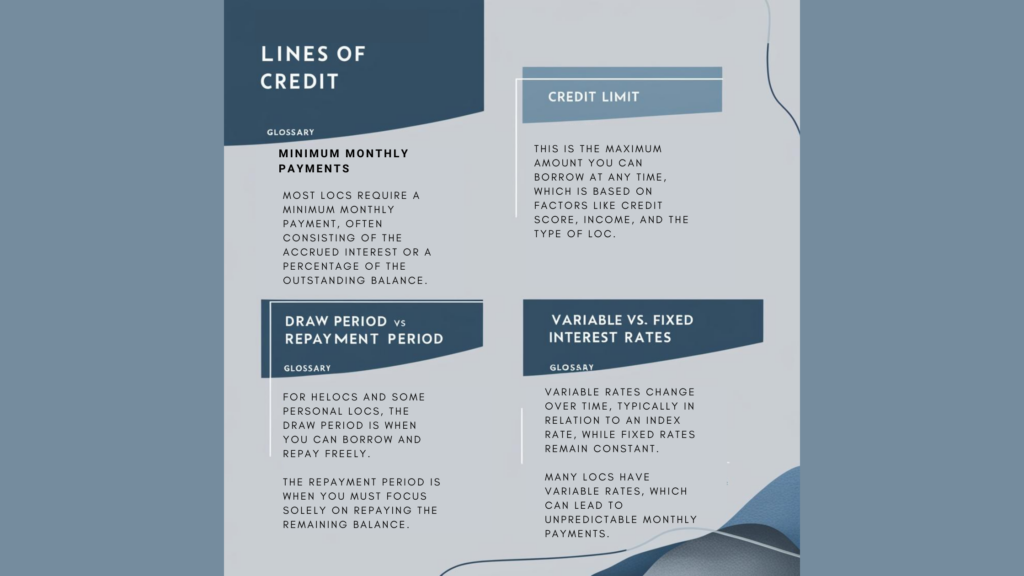Credit Lines 101: Your Guide to Understanding and Using Lines of Credit
A line of credit (LOC) is a flexible borrowing option that provides access to funds when you need them most, whether it’s covering unexpected expenses, funding a home renovation, or managing cash flow for a business. However, it’s essential to understand how credit lines work to use them responsibly. In this guide, we’ll dive into the basics of credit lines, the different types available, and tips for managing them wisely. With this knowledge, you’ll be equipped to make informed decisions that support your financial health.
What Is a Line of Credit?
A line of credit is a revolving loan that allows you to borrow money up to a predetermined limit, repay it, and then borrow again as needed. Unlike traditional loans, which provide a lump sum upfront, a line of credit offers flexibility—you can access funds at any time, as long as you stay within your credit limit.
Key Concepts:
- Credit Limit: The maximum amount of credit available to you.
- Draw Period vs. Repayment Period: Some LOCs, like home equity lines of credit (HELOCs), offer a draw period during which you can borrow and repay funds freely, followed by a repayment period where no new withdrawals are allowed.
- Variable vs. Fixed Interest Rates: LOCs often have variable interest rates, which can fluctuate over time, potentially affecting your monthly payment.

Types of Lines of Credit
There are several types of lines of credit, each suited to different financial needs and goals. Here’s a breakdown of the most common types:
- Personal Line of Credit: Often unsecured, this is a flexible option for covering expenses like home repairs or unexpected bills. It typically requires good credit to qualify.
- Home Equity Line of Credit (HELOC): A secured line of credit backed by the equity in your home. HELOCs are popular for funding renovations or large expenses, as they often offer lower interest rates compared to unsecured credit lines.
- Business Line of Credit: Designed for business owners, this type provides access to funds for managing cash flow, purchasing inventory, or covering operating expenses. It’s an invaluable resource for small businesses that need quick access to capital.
- Credit Cards as LOCs: Credit cards are essentially revolving credit lines with unique terms and features, such as rewards, cashback, and purchase protection. They can be a convenient way to borrow but often come with high interest rates if balances aren’t paid in full.

Pros and Cons of Using a Line of Credit
Pros:
- Flexibility: You have the freedom to borrow only what you need, when you need it, without committing to a fixed loan amount.
- Interest on the Amount Borrowed: With a line of credit, you only pay interest on the funds you use, unlike traditional loans.
- Useful for Emergencies and Cash Flow: LOCs are great for managing unexpected expenses or bridging financial gaps, especially for businesses.
Cons:
- Risk of Debt Accumulation: The flexibility of LOCs can lead to overspending, especially if there isn’t a repayment plan in place.
- Potentially High Interest Rates: Unsecured credit lines tend to have higher interest rates, and even secured LOCs like HELOCs can have variable rates that fluctuate.
- Fees: Some LOCs charge fees for setup, annual maintenance, or usage, which can add to the cost of borrowing.
Key Terms to Know When Considering a Credit Line
Understanding common terms can help you navigate credit lines more effectively:
- Credit Limit: This is the maximum amount you can borrow at any time, which is based on factors like credit score, income, and the type of LOC.
- Draw Period vs. Repayment Period: For HELOCs and some personal LOCs, the draw period is when you can borrow and repay freely. The repayment period is when you must focus solely on repaying the remaining balance.
- Variable vs. Fixed Interest Rates: Variable rates change over time, typically in relation to an index rate, while fixed rates remain constant. Many LOCs have variable rates, which can lead to unpredictable monthly payments.
- Minimum Monthly Payments: Most LOCs require a minimum monthly payment, often consisting of the accrued interest or a percentage of the outstanding balance.

When to Use a Line of Credit
Lines of credit can be beneficial when used for the right reasons. Here are a few scenarios where an LOC may be a smart choice:
Ideal Uses:
- Emergencies: LOCs can provide quick access to funds for unexpected expenses, like medical bills or car repairs.
- Home Renovations: A HELOC is especially useful for financing home improvements, which may increase the value of your property.
- Business Expenses: A business LOC can cover cash flow shortages, fund growth initiatives, or purchase inventory during peak seasons.
Situations to Avoid:
- Everyday Expenses: Relying on an LOC for routine expenses can lead to debt accumulation and reliance on borrowed money.
- Non-Essential Purchases: Avoid using LOCs for discretionary expenses, like vacations or luxury items, as this can quickly lead to high-interest debt.
Tips for Responsible Credit Line Management
Responsible use of a line of credit can help you enjoy its benefits while avoiding debt. Here are some tips for managing LOCs effectively:
- Borrow Only What You Need: Avoid drawing the full credit limit unless absolutely necessary, as this can lead to high monthly payments and interest costs.
- Make Regular Payments: Paying down the balance consistently helps you manage interest charges and frees up credit for future needs.
- Keep Track of Variable Rates: If you have a variable-rate LOC, be mindful of potential interest rate increases and how they may affect your payments.
- Avoid Using LOCs as Income: Treat an LOC as a tool for temporary financial flexibility, not as a source of income.
- Build a Repayment Plan: Set a goal for when you want to pay off the LOC, especially if you’re using it for significant expenses, like home renovations or business investments.

How Lines of Credit Affect Your Credit Score
Credit lines impact your credit score in several ways. Here’s how:
- Credit Utilization: Using a high percentage of your LOC limit can lower your score. Aim to keep utilization below 30% of your limit whenever possible.
- Payment History: Regular, on-time payments positively contribute to your credit report, while missed payments can significantly harm your score.
- Length of Credit History: Keeping LOC accounts open can improve the length of your credit history, a key factor in your overall credit score.
- Credit Inquiries: Applying for an LOC triggers a hard inquiry, which can temporarily lower your score. Avoid multiple applications in a short time.
What to Do If You’re Struggling to Manage a Line of Credit
If you’re having trouble keeping up with payments or managing your line of credit, consider these steps:
- Review and Adjust Your Budget: Identify areas where you can reduce spending to free up funds for LOC payments.
- Pay Down High-Interest Debts First: If you have multiple debts, focus on paying down higher-interest accounts first.
- Reach Out for Support: Debt Medic offers assistance in managing LOC debt, helping you explore options like debt consolidation and repayment planning.

Conclusion
Lines of credit offer a flexible solution for accessing funds, but they must be managed carefully to avoid debt. By understanding the different types of credit lines, knowing when and how to use them, and following responsible management tips, you can enjoy the benefits of LOCs without the drawbacks.
If you’re struggling with LOC debt or have questions about managing credit responsibly, Debt Medic is here to help. Our experienced team can provide guidance, resources and personalized solutions to help you regain control of your finances. Whether you need assistance consolidating debt, creating a repayment plan, or understanding your borrowing options, we’re here to support you every step of the way.
Lines of credit can be a valuable financial tool, but the key lies in responsible use and informed decision-making. Reach out to Debt Medic today to explore how we can help you make the most of your credit while ensuring long-term financial stability and peace of mind.
